A Charcoal Lesson
... how to achieve dramatic results
Here's a charcoal lesson for you to study. It will show you how I achieve realism and drama in my figure drawings. This is all done with charcoal.
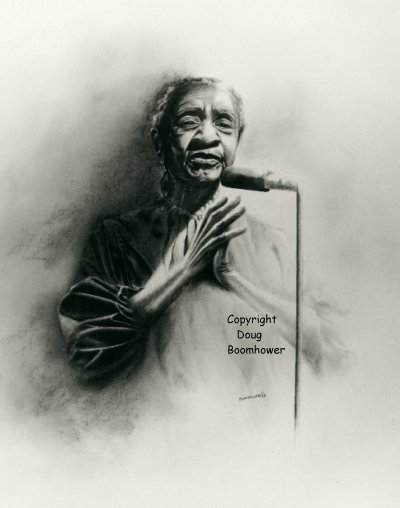
This is a charcoal drawing of the late, great blues and jazz singer, Alberta Hunter. She sang into her late eighties in New York. In this portrait, I am striving for a feeling of serenity.
I worked from a photo to draw the face but I completely changed the lighting. The rest of the portrait is my creation.
Charcoal Lesson - The Drawing Process
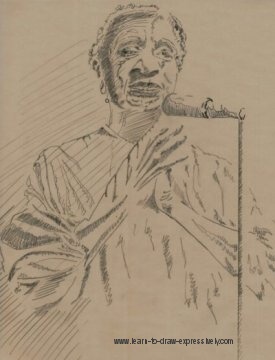
First I establish my initial drawing and layout in pencil. I indicate areas that will be shaded.
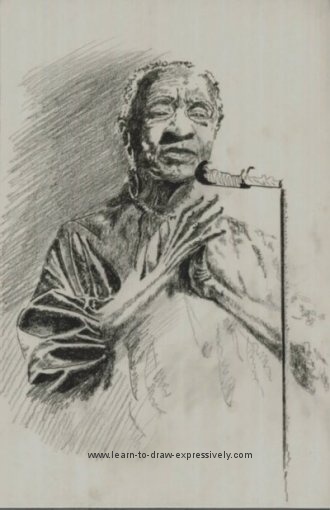
I elaborate on my initial drawing. I plan out the portrait in detail, so once I begin the charcoal drawing, I know where I am going.
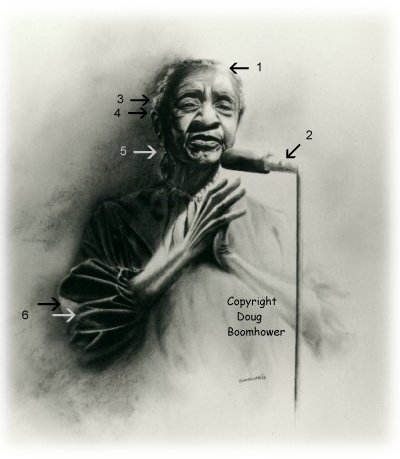
- Notice that her hairline disappears because there is no sharp delineation between forehead and hair. The forehead appears to “melt away”. This reinforces the overall impact of the stage lighting.
- Note that the top section of the microphone is only suggested. It also appears to “melt” into the background, reinforcing the intensity of the stage lighting.
- Notice the highlights on the hair contrasts nicely against the dark area.
- I indicate those areas of her ear which catch the light, and in doing so, I give definition to her ear.
- Highlighted area indicates her earring catching the light.
- Highlights indicate where her dress is catching the light, giving form to her puffed sleeve.
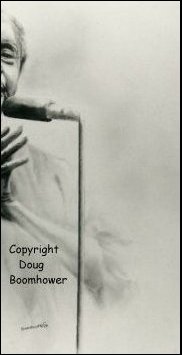
Note that the right side of the drawing has very little detail.
The implication here is that this side of the singer’s figure is washed away under the lighting. I did this with blending stumps and brushes.
Rather than adding charcoal, I used blending stumps that already held enough charcoal to create the subtle effect I wanted.
Further discussion of the portrait:
This charcoal lesson demonstrates the importance of light and shade . The light falling across the singer’s dress subtly follows the folds in her dress. (This attention to detail enhances the realism.)
Note that the shadowed side of the figure is not completely blocked out. Close observation will indicate that this area contains a lot of details, which are “peeking” through the shadows. For instance, the shadowed side of the singer’s face subtly reveals her hair, her ear, her cheek, and her earring.
The folds in her dress are also visible through the shadows.
Charcoal Lesson - The Power of Suggestion
I used a kneaded eraser to pull all of these details out of the shadows. This technique adds drama because you are only suggesting things rather than clearly exposing them.
Kneaded erasers are an important part of my charcoal art technique. In this case, I lay the charcoal down, and then draw on top of the charcoal with the eraser. Kneaded erasers are very malleable so I can shape them into points and then use them like "rubber pencils".
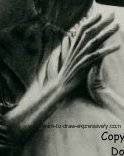
The arm and the hand on the left are also done with very little detail. I used brushes and soft charcoal here.
The arm, in fact, has no outline where it joins the dress, implying that it is washed away under the lighting. However, the viewer still imagines the upper edge of the arm.
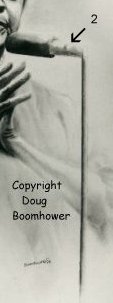
I put the microphone in:
- to create depth,
- to reinforce the lighting theme (see above for description of Arrow 2),
- and to balance the right and left sides of the picture.
Here is another charcoal lesson on how to draw metal textures!
And yet another lesson on drawing metal here.
To search my site, enter your search term in the box below, and click on the Search button. (Google ads may appear at the top of the results page ... your search results will be just below.)
Return from Charcoal Lesson to Home Page




